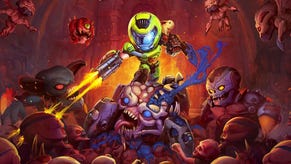Doom PS4 Review: The Beast is Back
Doom is back for the first time since 2004. Has it been worth the wait?
This article first appeared on USgamer, a partner publication of VG247. Some content, such as this article, has been migrated to VG247 for posterity after USgamer's closure - but it has not been edited or further vetted by the VG247 team.
Doom needs little in the way of introduction. Launched in 1993, the hugely important and influential title helped bring first-person shooters to the forefront of gaming. However, despite the series being so well regarded, iterations of the game have been somewhat of a rarity. There were two in the 90's within a year of one another, and then there was a decade-long gap between 1994's Doom II: Hell on Earth and the third game in the series.
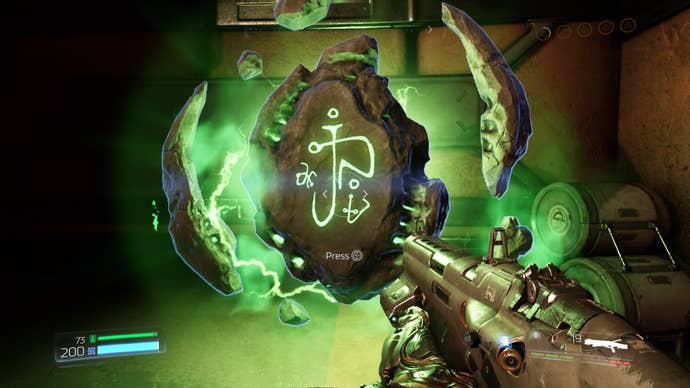
Now, after an even longer twelve-year wait, the fourth version of Doom is finally upon us, and, as a huge fan, I've been keen to find out whether the game is a classic throwback, or something completely new for the series. Turns out that it's the former – although while it does echo the past, it's essentially a modern take on the classic Doom gameplay.
The plot focuses on an unnamed marine who's freshly escaped – or let free, it's not really clear – from imprisonment on Mars. He walks into a world where all Hell has literally broken loose. Turns out that the Union Aerospace Corporation has been channeling Argent energy from Hell itself via a portal to create an infinite power source for Earth, thus solving mankind's energy crisis. To cut a long story short, renegade researcher Olivia Pierce has opened up the portal and demons have invaded Mars, and our friendly neighborhood Doom guy arrives just in time to potentially save the day. Guided by facility director Samuel Hayden, he takes on the mission to close down the portal and kill all invading demons – a task that spans a variety of locales from Mars to Hell itself.
I'm skimping somewhat on the details of the plot, simply because Doom's story feels more like the means to justify its action, rather than being a device to spin a detailed and cohesive narrative. There are few cut scenes – what little there is of the story is mostly told through audio vignettes that pop up between missions, and as you're running around. That's not a complaint, by the way. Doom is clearly an action-oriented game that's all about achieving objectives, and the journey through the game and what you do is essentially the story, rather than you feeling like you’re a part of some greater overall narrative.
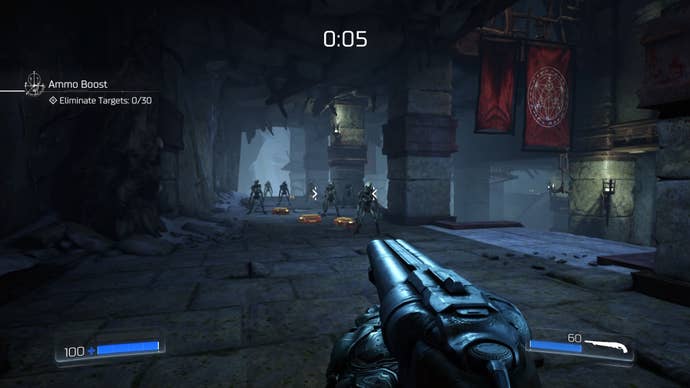
Jumping into the single-player campaign, the first thing that struck me was Doom's tremendous sense of speed. This is one very fast-playing game, both in the sense that its action moves along, and the way it encourages you to aggressively tackle its challenges. There are no cover mechanics, and you need to stay on the move while fighting – if you stand still for even a short length of time, you're likely to get nailed by one or more of the myriad of demons that populate each level.
Doom's biggest and most immediate new feature is its glory kills. When you shoot at a demon, you wear down its health to a point where it starts to glow. That's your signal to step up close and press R3 to melee your quarry to death in spectacular fashion. Apart from it looking gruesomely sweet, glory kills cause health power-ups and occasionally ammo to spew from your victim's body – and this is largely how you keep yourself alive. While most levels are typically littered with extra ammo and health power-ups, the action is so intense, and you're wading through so many enemies that you inevitably need to keep topping up your health bar by performing glory kills. It's a great system: One that essentially rewards aggressive play, and ensures that you're constantly in the thick of the action, scything down enemies in brutal style.
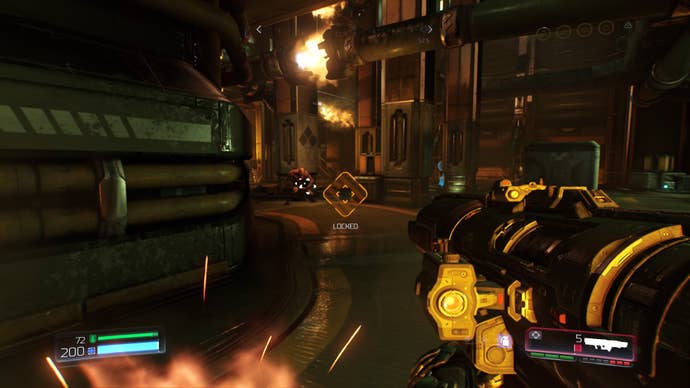
Another new aspect to the game is upgradable weaponry. I love that Doom features a classic array of weapons: There's the shotgun and super shotgun, plasma rifle, rail gun, rocket launcher, and heavy assault rifle. In default mode they're all hip-shooters, and feel great to use. However, you can upgrade them with mods that you can find hidden throughout the game, and then use L2 to fire advanced shots. In this fashion, for example, you can lock on to the enemy with the rocket launcher and fire a burst of three rounds in short succession, or build up heat with your plasma rifle and let it rip as an AOE effect. It's a neat idea that helps add a little additional depth and dimension to the way the weapons work, and opens up a few new tactics while fighting hordes of demons.
The game also includes the chainsaw and BFG, and, once you find them, they become mapped to their own unique joypad buttons. The BFG does exactly what you want it to do – and that's take out a horde of demons, or indeed knock a huge chunk off a boss' health bar. The chainsaw is a limited-use item that needs fuel to work. Assuming you're fully gassed up, it can be wielded to cut most demons in half – and the process creates a fountain of ammo that you can collect to pretty much refill your supplies in short order. That can be a lifesaver in certain protracted fights when you've exhausted all the ammo lying around a particular level.
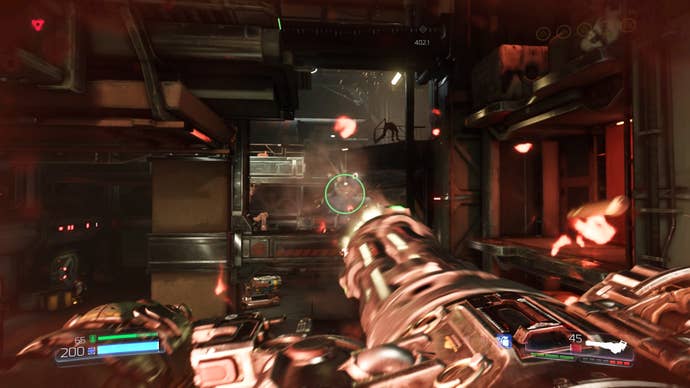
Doom's gameplay is somewhat compartmentalized. Basically, you move from objective to objective through a series of zones, and for the most part you can't access the next zone until you've killed everything in your current zone. In earlier levels, where the zones are more expansive, it doesn't feel restrictive, but as the game goes on, this mechanic is used more and more, and towards the latter stages, you're essentially locked in a long series of arenas where you have to defeat waves upon waves of demons before you're able to progress to the next one. The action is certainly fun, but over time can feel rather relentless – particularly as you end up fighting what feels like basically the same patterns of demons repeatedly across a series of different areas. One might be a more open environment, while another might be more dungeon-like, but the fight is basically a repeat of what you've done before. It almost feels like filler content – the game's limited roster of Demons being recycled a little too much to pad out the proceedings.
Another aspect of the game that didn't always work for me is that sometimes you need to find items on a level to unlock doors. For the most part, important objects are found fairly easily, but there are a couple of levels where it's easy to miss a keycard or skull, and that can lead to a lot of fruitless wandering about. Fortunately it didn't happen too often, but when it did it just wasn't much fun. I ended up tracing and retracing my steps until I finally found the cubbyhole in which was tucked away the item I was looking for.
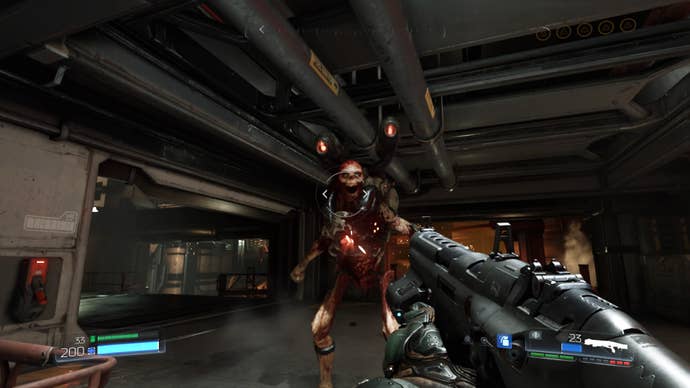
Fortunately, though, Doom's action is really solid and offsets its minor hiccups well enough. It's a blisteringly fast shooter whose innovative glory kill mechanics keep the proceedings feeling tight and visceral. The lock-in arena battles, while eventually becoming somewhat repetitive, are nevertheless really fun. Strafing is a key tactical component here, and you have to constantly stay on the move to survive. As a consequence, the action feels dynamic and kinetic – there's only time to breathe between levels.
The boss fights also echo that feeling of dynamism – they're tense encounters that will have you on the edge of your seat as you attempt to whittle down some giant demon's health bar. Most fights are quite easy to figure out what you need to do to survive each boss' offensive moves, but executing the moves perfectly to defeat them is another thing entirely. I often found myself yelling in anger and frustration while I was trying to master them, but once I got everything right, I felt a deep feeling of satisfaction having conquered them.
I also felt really satisfied when I completed the twelve-or-so-hour single-player campaign. The ending is a little perfunctory, but then that goes with the game's fairly lean plot. Doom has never been about the story – it's all about the action. And if you enjoy shooting things, this latest iteration of id's classic game really does deliver the goods. There's some repetition in its latter stages, but the action never lets up, and it's gloriously gory. The fact that it also looks fantastic, and sounds great is just the icing on the cake. Or should that be, the the skull on top of the offal?
InterfaceSnapMap is very well designed to be easy to use, but offers a huge amount of depth for those willing to put in the time and effort.
Lasting AppealThe three aspects of Doom - single-player campaign, multiplayer, and SnapMap - combine to offer an impressive range of activities that have tremendous lasting appeal.
SoundWhoever did the sound effects for this game must have had a lot of fun. Hell has never sounded so squelchy and visceral.
VisualsDoom's highly detailed graphics echo the original game's aesthetics, and look absolutely terrific.
Conclusionid Software has taken its original, no-BS Doom formula and very successfully repackaged it for the modern era. The result is a thrash metal loud, gloriously gory, blisteringly fast, and thoroughly entertaining oldschool shooter. Both the single-player and multiplayer modes are basically throwbacks to simpler times, but are wrapped up with contemporary trimmings to create a package that fans of the original Doom games should really enjoy.
Multiplayer
Like the single-player mode, Doom multiplayer is fast. Racing around its tight and sometimes labyrinthine levels at breakneck speeds takes some getting used to. It reminds me of playing the original Doom in a lot of ways. Perhaps I'm misremembering just how rapid and brutal oldschool Doom was, but that's new Doom in a nutshell.
Players choose two weapons for their loadout from a range of classic single-player tools, as well as a few specific multiplayer additions, such as a sniper rifle. It's a varied list that offers something for pretty much every playstyle imaginable, from picking off the opposition from afar to a close-range, run-and-gun style. I've mostly been using the rocket launcher, since I really enjoy that weapon's style and splash damage, combined with a super shotgun for close-up kills. Neither weapons are "the best," but they work together to create a playstyle that works for me. That's one of the great things about Doom's weapon selection – I'm hard pressed to think of a playstyle that isn't catered for.

Doom multiplayer's roster of modes features the usual suspects like Team Deathmatch, Domination, and Soul Harvest (aka Kill Confirmed). However while the former two play pretty much as you'd expect, Soul Harvest has a twist. When playing in any mode, a demon rune appears at regular intervals in the center of the map that you can collect to transform your marine into a stomping great demon for a limited period of time. There are four different demons types (one of which you choose on the lobby screen as part of your loadout), and each has its own different playstyle, from more melee-oriented to a ranged demon that fires missiles.
In Soul Harvest, the first player to die drops a demon rune that doesn't have a timer. Players killed by a demon drop two souls, while killing a player who's transformed into a demon sees five souls drop – as well as a demon rune. This is a recipe for some very entertaining action that can sometimes feel like pure mayhem. Because of the demon's size, it automatically becomes the target of all enemy players, and this can result in spectacular firefights, with the somewhat overpowered demon smashing its way through the opposition while the enemy tries to take it down.
A new mode – well, it's another riff on a typical PvP theme – is Warpath. Here, a capture point moves along a set course around the map, and the objective is to simply control it to garner points. The mobile node focuses the action in a specific area, and again creates really entertaining firefights that are fast, frenetic and fun.
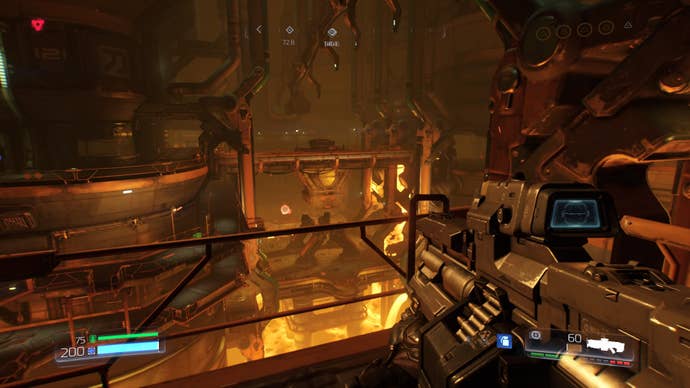
Perhaps the most original mode is Freeze Tag. Here, downed players are frozen in place and have to be thawed by an ally standing next to them. The objective is to be the first team to completely freeze the opposition. Where this mode becomes entertaining is that you can shoot frozen players to send them sliding across the frozen landscape, perhaps denying an enemy the chance to unfreeze one of their teammates, or sending a frozen ally toppling into a chasm, which will unfreeze them and cause them to respawn. It's a really fun mode, and one that can lead to great comebacks and clutch moments – which is what multiplayer games should be all about.
As I've already said, the pace of Doom's multiplayer action is frenetic. Most weapons are very powerful, and close encounters between players are usually settled in a matter of fractions of seconds. This can feel a little off-putting at first, but once you get used to the furious speed of the action, it becomes hugely entertaining. Doom is essentially a battle of reflexes and reactions, just like it used to be – it's definitely not a finesse shooter like Call of Duty: Black Ops III. There's something distinctly messy about its action that might not work for players who really enjoy shooters that have really crisp precision, but if you're a fan of bouncing around while shooting at an enemy who's very likely doing the same, you'll probably really enjoy what Doom has to offer.
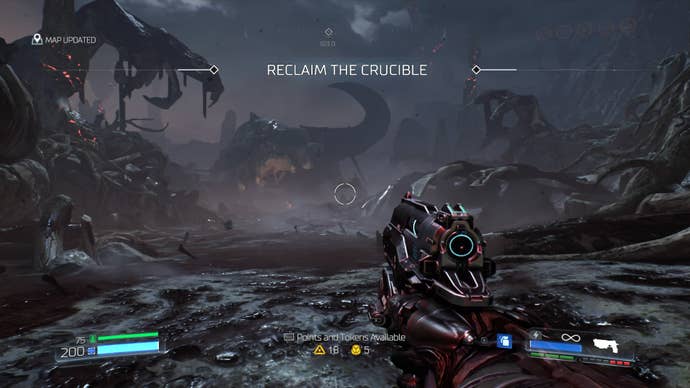
As well as liking Doom's style of action, I'm also a fan of the way the game's nine maps are designed. They're generally quite tight, with lots of platforms and elevation changes, and few places where you can effectively camp. While some levels do have more open areas, most maps consist of rooms connected together by passageways, making them feel almost maze-like. They're just fun to run around, and give you plenty of opportunity to use line-of-sight to block incoming enemy shots. Each map also features plenty of health, ammo, armor, and power-ups, so as long as you stay on the move, you can keep yourself topped up. Some maps also feature precipitous drops and hazards, and if I'm being honest, I've killed myself more than a few times mistiming jumps and doing dumb things like running backwards into a fiery pit. But to me it's all part of the fun: You have to keep an eye out on where you are, and be aware that some levels can bite you in the ass if you're careless.
Beyond the action, Doom's multiplayer offers leveling and customization options. You earn random limited-time perks while playing that you can use to give yourself a in-game boost when you respawn. None of them are game-breaking, but they can give you a temporary advantage, such as being able to see players through a wall, or a trail of enemy footprints. You can also win different pieces of armor and paints that enable you to cosmetically customize your avatar's look. I'm always a sucker for these kinds of features, and have spent time giving my marine its own unique look by mixing and matching various armor pieces. And it seems I'm not the only one who likes playing dress up dolly with their marine – most players seem to have customized their characters, judging by what I've seen on the multiplayer startup screens that show your team's avatars.

SnapMap
Doom's third aspect is SnapMap, a tool that enables you to become a budding Doom designer and create and share your own levels. I played around with it for a while, and was very impressed, although to be honest, it's just not my cup of tea. While it does seem easy to use – I was able to put together a really basic level from a template in a matter of minutes – I'm far more interested in spending time playing the game, rather than making my own levels. However, if designing levels is your thing, SnapMap is a comprehensive tool that enables you to unleash your creativity in a wide variety of ways.
While it's easy to create basic stuff, the tool seems to have tremendous depth if the tutorials are anything to go by. There's a myriad of different tweakable options available, from playing around with game settings, AI logic, and general behavior to the way that players interact with objects. It's clear that if you put in the time, you're able to create quite sophisticated levels that range from objective-based shooting to specific challenges. How do I know this? I played a bunch of top-rated levels and was really impressed with their variety and overall feeling of completeness. They were essentially mini-games in their own right, and if you're after some extra-curricular Doom activity after you've completed the single-player mode, and don't necessarily fancy playing multiplayer, SnapMap's offerings are a really pleasant surprise.
While I don't have the patience to ever use SnapMap, I can see its appeal, and to me it's just an excellent piece of value add to the overall Doom package.
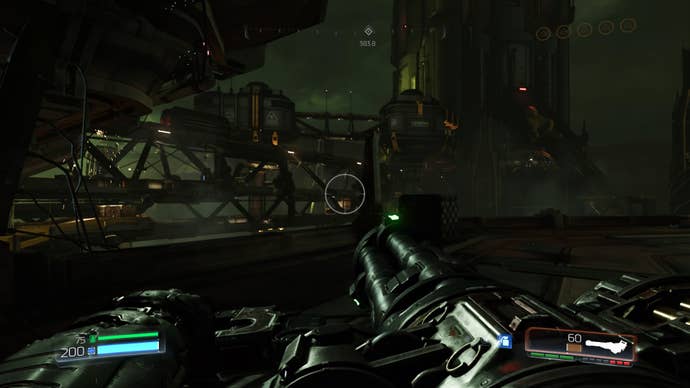
Summing Up
And that overall package is a really slick and polished one. The single-player campaign is a blisteringly fast, gruesomely gory experience that, while feeling somewhat padded out towards its latter stages, nevertheless delivers a rip-roaring ride that's challenging and thoroughly entertaining. Forget the plot, and just enjoy running around, single-handedly blasting the seven shades of crap out of a hellspawn of demons using a toolbox of great-feeling weapons. Ultimately, it's oldschool-feeling FPS action, and it's great.
Like the single-player campaign, the multiplayer mode is also a throwback to simpler times. Although it does have some modern day trappings grafted onto it, it's basically a twitch-based run-and-gun shooter that's fast, messy, and a lot of fun. It's definitely not for everyone, but if you grew up on Arena shooters like me, I think you'll like what it offers.
Both those aspects combine with SnapMap to deliver a comprehensive offering that helps bring Doom back to the forefront of gaming. It's been a long time coming, but the wait was definitely worth it.
InterfaceSnapMap is very well designed to be easy to use, but offers a huge amount of depth for those willing to put in the time and effort.
Lasting AppealThe three aspects of Doom - single-player campaign, multiplayer, and SnapMap - combine to offer an impressive range of activities that have tremendous lasting appeal.
SoundWhoever did the sound effects for this game must have had a lot of fun. Hell has never sounded so squelchy and visceral.
VisualsDoom's highly detailed graphics echo the original game's aesthetics, and look absolutely terrific.
Conclusionid Software has taken its original, no-BS Doom formula and very successfully repackaged it for the modern era. The result is a thrash metal loud, gloriously gory, blisteringly fast, and thoroughly entertaining oldschool shooter. Both the single-player and multiplayer modes are basically throwbacks to simpler times, but are wrapped up with contemporary trimmings to create a package that fans of the original Doom games should really enjoy.



